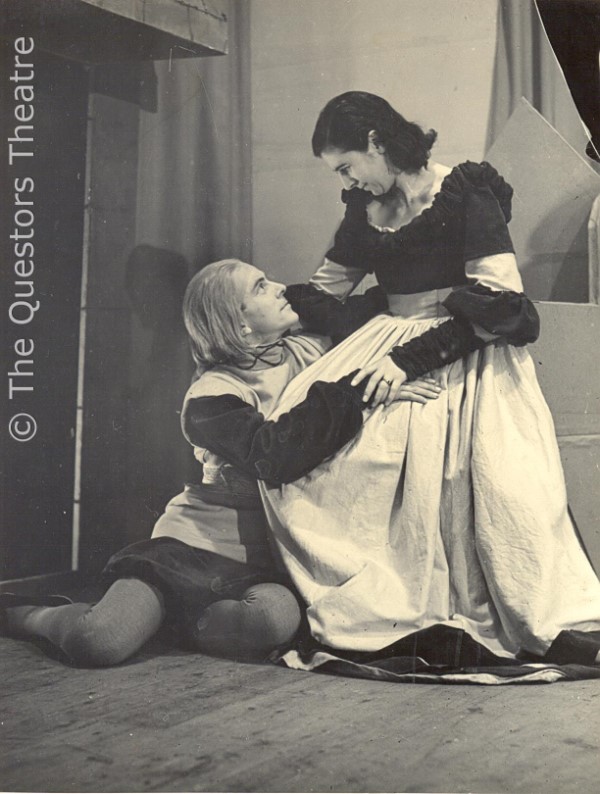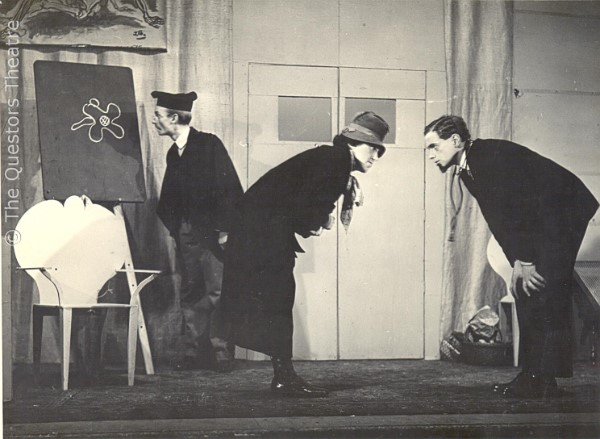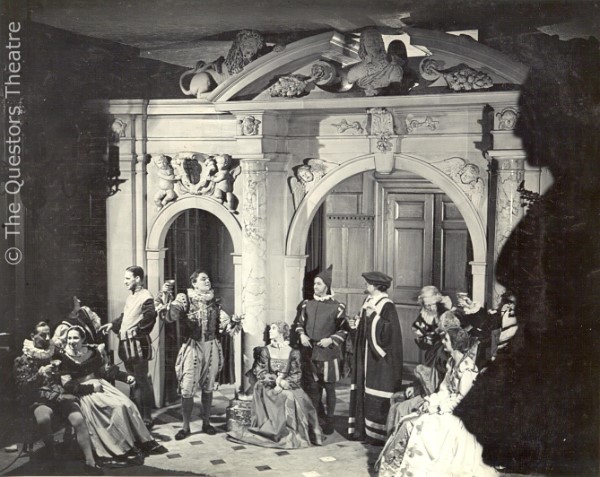
SEASON 6 (1934-35)
The Witch
Dr Knock
The Taming of the Shrew
March 1934
THE WITCH
by H Wiers-Jenssen
adapted by John Masefield
Directed by Alfred Emmet
Designed by Audrey Perkins

Although box office takings were disappointing, this was considered by everyone to be The Questors' most polished production so far and it won a trophy from The West Middlesex Dramatic and Operatic Federation.
"If you are taking away from this performance some memories of beauty and of truth, all efforts we have put into the production have been amply repaid." Alfred Emmet addressed the audience with these words after the final performance of what the Middlesex County Times described as "the most perfect production [The Questors} have yet staged".
Alfred Emmet later recalled the simplicity of the setting, which consisted of a pillar and the stained-glass window (part of the original old chapel) at the back of the stage, lit from the outside, to suggest the interior of a cathedral.
 The County Times reviewer went on to praise The Questors for breaking new ground in the choice of the play and in it's interpretation. "Sheer sincerity was perhaps the outstanding virtue of the production backed by strength and polish."
The County Times reviewer went on to praise The Questors for breaking new ground in the choice of the play and in it's interpretation. "Sheer sincerity was perhaps the outstanding virtue of the production backed by strength and polish."
He was also impressed with the innovative use of entrances in front of the proscenium:
"Like so many shadows from different doors in the hall, sacristans, men, women, priests, aldermen and officials padded in almost uncanny silence to take their place on the stage in the dim religious atmosphere of the final cathedral scene."
This procession included 8 boys from St Paul's School, Hammersmith, singing a funeral chant.
December 1934
DR KNOCK
by Jules Romain
translated by Harley Granville Barker
Directed by Christopher Spurrier

This production of the Jules Romain farce saw Alfred Emmet for once taking centre stage - to great effect it seems!
"The success or otherwise of any production of this play lies almost entirely in the manner in which the character of Dr. Knock pulls or fails to pull its full weight. Mr. Emmet gave it the kind of prominence and insistence it requires; his acting, was tense, rightly focussed, highly polished and percipient. His sleek, well-groomed appearance, his ability to let the audience see the working of his brain, as it were, all combined in a brilliant portrait study, which, while stressing the money-making shrewdness of the doctor, did not altogether leave out of account his curious strain of whimsical idealism. Mr. Emmet has made great strides in acting of late; he goes down deeper and rises higher, and his playing in the second act could hardly have been bettered." ["C.C." Middlesex County Times ]

The play began with some surreal comedy involving a ramshackle motor car:
"I particularly liked his burlesque motor car and the way the occupants walked it round the stage to suggest part of a journey. Here Mr. Spurrier [the director]showed sufficient confidence in himself to achieve an excellent effect at the small risk of looking ridiculous." ["L.J.D." Middlesex County Times]
May 1935
THE TAMING OF THE SHREW
by William Shakespeare
Directed & designed by Alfred Emmet

The Questors first Shakespeare production.
In his programme note, Alfred Emmet offered some justification for not having chosen a play more representative of our national dramatist at his best. "We ask your indulgence. This is our first Shakespearean venture, and if we learn to walk with "The Shrew," we may yet run with "Macbeth," or even fly with "Hamlet" or "Lear".
As it happens, MACBETH would have to wait another three years, HAMLET" twenty years and LEAR forty years, by which time the Tin Hut had been replaced by our new playhouse.
In fact the second Shakespeare production at Questors was TWELFTH NIGHT the following year and the choice of that play gave rise to some lively controversy - which you can read about in Season 7.
 The photos attached to this article (the only ones we have in our archives) were taken when the Questors visited Swakeleys House, Ickenham, for an open air performance in June 1935. The magnificent screen in the Great Hall in front of which the cast are posing, is in complete contrast to Alfred Emmet's setting on the Questors Stage described here by the Middlesex Count Times reviewer:
The photos attached to this article (the only ones we have in our archives) were taken when the Questors visited Swakeleys House, Ickenham, for an open air performance in June 1935. The magnificent screen in the Great Hall in front of which the cast are posing, is in complete contrast to Alfred Emmet's setting on the Questors Stage described here by the Middlesex Count Times reviewer:
"The simple, dignified setting, designed by Mr. Alfred Emmet, which, while never obtrusive, always contrived to add point to the spectacle presented on the stage. The action of the play was immeasurably expedited by the construction of a forestage, which also added to the Elizabethan atmosphere of the production and by the judicious use of banks of drawn curtains which enabled the many different scenes to follow rapidly on one another without the usual tiresome intervals."
Questors trivia: with this production and for the next two or three years the Questors started calling the Tin Hut "Mattock Hall"!


 The County Times reviewer went on to praise The Questors for breaking new ground in the choice of the play and in it's interpretation. "Sheer sincerity was perhaps the outstanding virtue of the production backed by strength and polish."
The County Times reviewer went on to praise The Questors for breaking new ground in the choice of the play and in it's interpretation. "Sheer sincerity was perhaps the outstanding virtue of the production backed by strength and polish."


 The photos attached to this article (the only ones we have in our archives) were taken when the Questors visited Swakeleys House, Ickenham, for an open air performance in June 1935. The magnificent screen in the Great Hall in front of which the cast are posing, is in complete contrast to Alfred Emmet's setting on the Questors Stage described here by the Middlesex Count Times reviewer:
The photos attached to this article (the only ones we have in our archives) were taken when the Questors visited Swakeleys House, Ickenham, for an open air performance in June 1935. The magnificent screen in the Great Hall in front of which the cast are posing, is in complete contrast to Alfred Emmet's setting on the Questors Stage described here by the Middlesex Count Times reviewer: